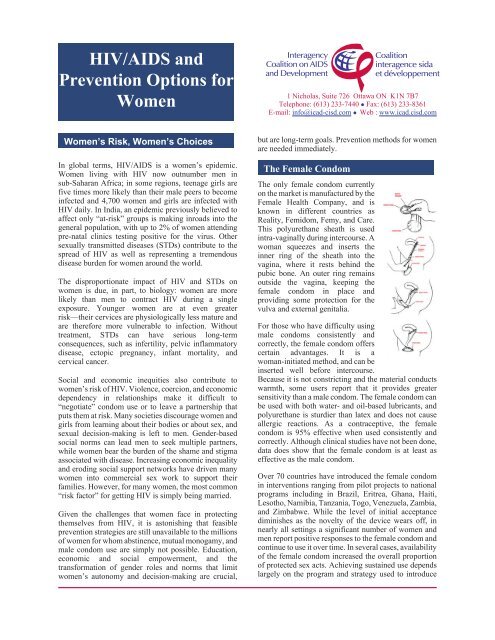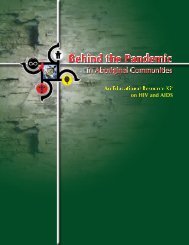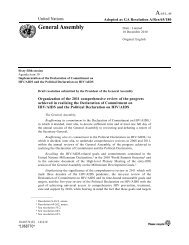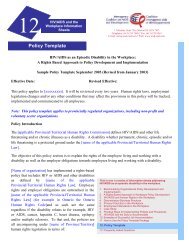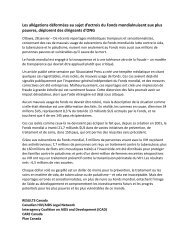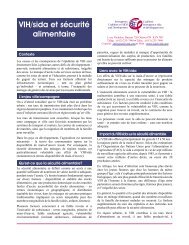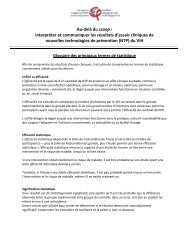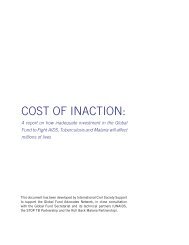HIV/AIDS and Prevention Options for Women - Interagency Coalition ...
HIV/AIDS and Prevention Options for Women - Interagency Coalition ...
HIV/AIDS and Prevention Options for Women - Interagency Coalition ...
You also want an ePaper? Increase the reach of your titles
YUMPU automatically turns print PDFs into web optimized ePapers that Google loves.
<strong>HIV</strong>/<strong>AIDS</strong> <strong>and</strong><br />
<strong>Prevention</strong> <strong>Options</strong> <strong>for</strong><br />
<strong>Women</strong><br />
1 Nicholas, Suite 726 Ottawa ON K1N 7B7<br />
Telephone: (613) 233-7440 Fax: (613) 233-8361<br />
E-mail: info@icad-cisd.com Web : www.icad.cisd.com<br />
<strong>Women</strong>’s Risk, <strong>Women</strong>’s Choices<br />
In global terms, <strong>HIV</strong>/<strong>AIDS</strong> is a women’s epidemic.<br />
<strong>Women</strong> living with <strong>HIV</strong> now outnumber men in<br />
sub-Saharan Africa; in some regions, teenage girls are<br />
five times more likely than their male peers to become<br />
infected <strong>and</strong> 4,700 women <strong>and</strong> girls are infected with<br />
<strong>HIV</strong> daily. In India, an epidemic previously believed to<br />
affect only “at-risk” groups is making inroads into the<br />
general population, with up to 2% of women attending<br />
pre-natal clinics testing positive <strong>for</strong> the virus. Other<br />
sexually transmitted diseases (STDs) contribute to the<br />
spread of <strong>HIV</strong> as well as representing a tremendous<br />
disease burden <strong>for</strong> women around the world.<br />
The disproportionate impact of <strong>HIV</strong> <strong>and</strong> STDs on<br />
women is due, in part, to biology: women are more<br />
likely than men to contract <strong>HIV</strong> during a single<br />
exposure. Younger women are at even greater<br />
risk—their cervices are physiologically less mature <strong>and</strong><br />
are there<strong>for</strong>e more vulnerable to infection. Without<br />
treatment, STDs can have serious long-term<br />
consequences, such as infertility, pelvic inflammatory<br />
disease, ectopic pregnancy, infant mortality, <strong>and</strong><br />
cervical cancer.<br />
Social <strong>and</strong> economic inequities also contribute to<br />
women’s risk of <strong>HIV</strong>. Violence, coercion, <strong>and</strong> economic<br />
dependency in relationships make it difficult to<br />
“negotiate” condom use or to leave a partnership that<br />
puts them at risk. Many societies discourage women <strong>and</strong><br />
girls from learning about their bodies or about sex, <strong>and</strong><br />
sexual decision-making is left to men. Gender-based<br />
social norms can lead men to seek multiple partners,<br />
while women bear the burden of the shame <strong>and</strong> stigma<br />
associated with disease. Increasing economic inequality<br />
<strong>and</strong> eroding social support networks have driven many<br />
women into commercial sex work to support their<br />
families. However, <strong>for</strong> many women, the most common<br />
“risk factor” <strong>for</strong> getting <strong>HIV</strong> is simply being married.<br />
Given the challenges that women face in protecting<br />
themselves from <strong>HIV</strong>, it is astonishing that feasible<br />
prevention strategies are still unavailable to the millions<br />
of women <strong>for</strong> whom abstinence, mutual monogamy, <strong>and</strong><br />
male condom use are simply not possible. Education,<br />
economic <strong>and</strong> social empowerment, <strong>and</strong> the<br />
trans<strong>for</strong>mation of gender roles <strong>and</strong> norms that limit<br />
women’s autonomy <strong>and</strong> decision-making are crucial,<br />
but are long-term goals. <strong>Prevention</strong> methods <strong>for</strong> women<br />
are needed immediately.<br />
The Female Condom<br />
The only female condom currently<br />
on the market is manufactured by the<br />
Female Health Company, <strong>and</strong> is<br />
known in different countries as<br />
Reality, Femidom, Femy, <strong>and</strong> Care.<br />
This polyurethane sheath is used<br />
intra-vaginally during intercourse. A<br />
woman squeezes <strong>and</strong> inserts the<br />
inner ring of the sheath into the<br />
vagina, where it rests behind the<br />
pubic bone. An outer ring remains<br />
outside the vagina, keeping the<br />
female condom in place <strong>and</strong><br />
providing some protection <strong>for</strong> the<br />
vulva <strong>and</strong> external genitalia.<br />
For those who have difficulty using<br />
male condoms consistently <strong>and</strong><br />
correctly, the female condom offers<br />
certain advantages. It is a<br />
woman-initiated method, <strong>and</strong> can be<br />
inserted well be<strong>for</strong>e intercourse.<br />
Because it is not constricting <strong>and</strong> the material conducts<br />
warmth, some users report that it provides greater<br />
sensitivity than a male condom. The female condom can<br />
be used with both water- <strong>and</strong> oil-based lubricants, <strong>and</strong><br />
polyurethane is sturdier than latex <strong>and</strong> does not cause<br />
allergic reactions. As a contraceptive, the female<br />
condom is 95% effective when used consistently <strong>and</strong><br />
correctly. Although clinical studies have not been done,<br />
data does show that the female condom is at least as<br />
effective as the male condom.<br />
Over 70 countries have introduced the female condom<br />
in interventions ranging from pilot projects to national<br />
programs including in Brazil, Eritrea, Ghana, Haiti,<br />
Lesotho, Namibia, Tanzania, Togo, Venezuela, Zambia,<br />
<strong>and</strong> Zimbabwe. While the level of initial acceptance<br />
diminishes as the novelty of the device wears off, in<br />
nearly all settings a significant number of women <strong>and</strong><br />
men report positive responses to the female condom <strong>and</strong><br />
continue to use it over time. In several cases, availability<br />
of the female condom increased the overall proportion<br />
of protected sex acts. Achieving sustained use depends<br />
largely on the program <strong>and</strong> strategy used to introduce
the female condom as a new method. The breadth of<br />
experience of different countries has generated many<br />
lessons learned.<br />
Positioning the female condom as a contraceptive, a<br />
dual-protection method, or as an <strong>HIV</strong>-prevention method<br />
can affect whether people are likely to use it with regular<br />
or casual partners.<br />
Counseling <strong>and</strong> support are crucial in helping women<br />
learn how to use the female condom successfully;<br />
problems most commonly reported by users tend to<br />
resolve with practice.<br />
Men as well as women need to be considered a “target<br />
audience” to encourage partner support in choosing <strong>and</strong><br />
using the method <strong>and</strong> to help remove the “novelty.”<br />
Providers’ attitudes greatly influence clients’ acceptance<br />
<strong>and</strong> long-term use. Providers need to be specifically<br />
trained in using <strong>and</strong> demonstrating the female condom.<br />
Fortunately, many resources are available to assist in<br />
making these decisions <strong>and</strong> in laying out a plan to<br />
introduce female condoms, either as part of <strong>HIV</strong><br />
prevention programs, family planning programs, or both<br />
(see “Resources.”)<br />
Because the female condom is made of polyurethane<br />
rather than latex, it is both sturdier <strong>and</strong> more expensive to<br />
manufacture than the male condom. The Female Health<br />
Company <strong>and</strong> UN<strong>AIDS</strong> have negotiated a public sector<br />
price of US$0.58 per condom. Though less than the<br />
commercial price of $2 to $3, this is still dramatically<br />
higher than the cost of male condoms, <strong>and</strong> in most LDC<br />
settings the female condom must be subsidized. Though<br />
cost is a large concern when policy makers are allocating<br />
limited budgets, modeling has shown that well-designed<br />
female condom programs are highly cost effective, <strong>and</strong><br />
even cost-saving, in terms of disease averted.<br />
Cervical Barrier Methods<br />
<strong>Women</strong>’s greater biological vulnerability to heterosexual<br />
transmission of <strong>HIV</strong> is likely due to the nature of the<br />
cervix. Unlike the vaginal epithelium, which consists of<br />
several layers of flat, sturdy squamous cells, parts of the<br />
surface of the cervix are made up of a single layer of<br />
fragile columnar cells (like the rectum), which are more<br />
easily damaged. Some bacterial STDs, such as Neisseria<br />
gonorrhoeae <strong>and</strong> Chlamydia, particularly target the<br />
cervical epithelium <strong>and</strong> are incapable of replicating in the<br />
squamous epithelium of the vagina. In addition, evidence<br />
shows that several target cells <strong>for</strong> <strong>HIV</strong>, including CD-4<br />
cells, are found much more frequently on the cervix than<br />
throughout the rest of the vagina. Another factor in<br />
female <strong>HIV</strong> acquisition may be the passage of infectious<br />
fluids into the upper genital tract (also highly<br />
susceptible) via the cervix. All of these factors suggest<br />
that a cervical barrier could significantly reduce a<br />
woman’s risk of <strong>HIV</strong> or STD infection. A cervical<br />
barrier used with a microbicide may provide even more<br />
protection.<br />
Barrier methods that protect the cervix include the<br />
diaphragm, cervical cap, <strong>and</strong>, to a lesser extent, the<br />
contraceptive sponge. Some cervical barriers are<br />
currently on the market <strong>and</strong> others are being developed<br />
or redesigned. Interest in <strong>and</strong> acceptability of an<br />
intra-vaginal barrier such as a diaphragm <strong>for</strong> <strong>HIV</strong><br />
prevention has been demonstrated in Zimbabwe.<br />
Diaphragms are well accepted in sexually active<br />
Zimbabwean women. However, research to<br />
demonstrate the efficacy of cervical barrier methods<br />
(either alone or with a chemical protectant) in<br />
preventing <strong>HIV</strong> in the absence of a condom is only just<br />
beginning.<br />
Female Condom Reuse<br />
Several studies have attempted to determine the<br />
safety <strong>and</strong> acceptability of reusing the female<br />
condom in an ef<strong>for</strong>t to make it more economical <strong>and</strong><br />
accessible. WHO convened two expert consultations<br />
to review the various studies <strong>and</strong> <strong>for</strong>m<br />
recommendations. Their statement was released at<br />
the XIV International <strong>AIDS</strong> Conference in Barcelona<br />
in July 2002. While WHO continues to recommend<br />
the use of a new male or female condom <strong>for</strong> every act<br />
of intercourse, the statement acknowledges that, <strong>for</strong><br />
some, the alternative to reuse could be unprotected<br />
intercourse. For these cases, WHO has developed a<br />
protocol <strong>for</strong> cleaning <strong>and</strong> re-lubricating the female<br />
condom, involving soaking in a bleach solution <strong>and</strong><br />
patting dry. This creates a hierarchical public health<br />
message: use of a new male or female condom is the<br />
primary recommendation; cleaning <strong>and</strong> reuse is the<br />
second recommendation. Currently, the decision to<br />
educate <strong>and</strong> train clients to reuse the female condom<br />
rests with program leaders <strong>and</strong> providers.<br />
For more in<strong>for</strong>mation see:<br />
www.who.int/reproductive-health/rtis/reuse.en.html<br />
Microbicides<br />
The word “microbicides” refers to a range of different<br />
products that share one common characteristic: the<br />
ability to prevent the sexual transmission of <strong>HIV</strong> <strong>and</strong><br />
other STDs when applied topically in the vagina.<br />
C<strong>and</strong>idates <strong>for</strong> a “first generation” microbicide are also<br />
evaluated <strong>for</strong> safety <strong>for</strong> rectal use; efficacy <strong>for</strong> rectal<br />
use is important but will most likely have to be<br />
established separately from efficacy as a vaginal<br />
product. Microbicides can be produced in many <strong>for</strong>ms,<br />
2 <strong>HIV</strong>/<strong>AIDS</strong> <strong>and</strong> <strong>and</strong> <strong>Prevention</strong> <strong>Options</strong> <strong>for</strong> <strong>Women</strong>
including gels, creams, suppositories, films, or as a<br />
sponge or ring that releases an active ingredient over<br />
time. Microbicides could prevent <strong>HIV</strong> <strong>and</strong> STDs by:<br />
• killing or otherwise immobilizing pathogens<br />
• enhancing the vagina’s natural defenses<br />
• blocking infection by creating a barrier between<br />
the pathogen <strong>and</strong> target cells;<br />
• preventing infection from spreading to other cells<br />
Ideally, a microbicide would combine some of these<br />
mechanisms <strong>for</strong> extra effectiveness. Eventually, a single<br />
microbicide could be effective against a broad range of<br />
sexually transmitted pathogens, including <strong>HIV</strong>. Some<br />
microbicides would be contraceptives <strong>and</strong> some would<br />
not, providing a much-needed option <strong>for</strong> women <strong>and</strong><br />
couples that wish to conceive children without<br />
compromising their health.<br />
“The <strong>Prevention</strong> Equation”<br />
The level of protection conferred (the number of<br />
infections averted) depends on three factors:<br />
• efficacy of the method<br />
• consistency of use within a partnership<br />
• extent of use within a sub-population<br />
A microbicide—a low-efficacy method—used with<br />
high levels of consistency would offer the same<br />
protection as a high-efficacy method—the<br />
condom—used less consistently. A 90% efficacious<br />
method used 20% of the time prevents fewer infections<br />
than:<br />
• 70% efficacious method used 30% of the time, or<br />
• 50% efficacious method used 40% of the time, or<br />
• 30% efficacious method used 60% of the time.<br />
Source: Watts, et al.<br />
It is unlikely that microbicides will ever be 100%<br />
effective, or even as effective as male or female<br />
condoms on a per-intercourse basis. However, the<br />
contribution of any given method to preventing<br />
infection within a population depends not only on its<br />
efficacy but also the coverage within a population <strong>and</strong><br />
consistency of use within relationships.<br />
Mathematical modeling that shows that if even a small<br />
proportion of women in lower income countries used a<br />
60% efficacious microbicide in half the sexual<br />
encounters where condoms are not used, 2.5 million<br />
<strong>HIV</strong> infections could be averted over three years.<br />
Though no microbicide has yet been proven safe <strong>and</strong><br />
effective, scientists are pursuing nearly 60 leads,<br />
including fourteen products that are currently in clinical<br />
human trials. With sufficient investment of resources<br />
<strong>and</strong> political will, one of these products could be<br />
available as early as 2007. Microbicides will likely be<br />
available be<strong>for</strong>e an <strong>HIV</strong> vaccine, <strong>and</strong> will continue to<br />
complement vaccines in an overall <strong>HIV</strong>/STD<br />
prevention strategy once they do exist.<br />
A Call to Action<br />
<strong>Women</strong> worldwide are asking <strong>for</strong> prevention options<br />
that better meet their needs. A grassroots movement in<br />
Zimbabwe convinced the government to add the female<br />
condom to national family planning programs. <strong>Women</strong><br />
elsewhere have articulated the need <strong>for</strong> prevention<br />
methods over which they have control—without ever<br />
having heard specifically of microbicides or<br />
intravaginal barriers. In spite of these ef<strong>for</strong>ts, prevention<br />
options <strong>for</strong> women has been a marginalized issue among<br />
policy makers, programmers, <strong>and</strong> donors. This may be<br />
to due to long-st<strong>and</strong>ing provider bias against barrier<br />
methods in family planning programs, or to general<br />
discom<strong>for</strong>t with interventions that specifically focus on<br />
sexuality. There is a general perception that women<br />
living in conservative societies will not use vaginal<br />
methods, though this assumption has been disputed by<br />
research. A lack of in<strong>for</strong>mation about these methods has<br />
led to an excuse <strong>for</strong> inaction.<br />
“The female condom needs more financial <strong>and</strong><br />
program support from donors, NGOs, <strong>and</strong> the<br />
international community, to ensure that women<br />
who would benefit most have access to it.”<br />
-Peter Piot, executive director of UN<strong>AIDS</strong><br />
In addition to ‘idelogical’ barriers, prevention options<br />
<strong>for</strong> women face real financial constraints. They are<br />
classic public health goods, which offer a tremendous<br />
benefit to society but <strong>for</strong> which there is little incentive<br />
<strong>for</strong> private investment. The fastest way to reduce the<br />
unit price of the existing female condom is to increase<br />
global volume through bulk purchases. An investment<br />
of $10 million today in female condom activities would<br />
reduce the cost of the female condom by over 25%;<br />
provide program, financial, <strong>and</strong> technical support to<br />
dozens of national, regional, <strong>and</strong> community programs;<br />
<strong>and</strong> offer women a way to protect themselves right now.<br />
Such an investment would also help build a solid<br />
foundation of programs <strong>and</strong> networks of providers,<br />
programmers, policy makers, users, <strong>and</strong> partners <strong>for</strong> the<br />
introduction of future prevention methods such as<br />
microbicides.<br />
<strong>HIV</strong>/<strong>AIDS</strong> <strong>and</strong> <strong>and</strong> <strong>Prevention</strong> <strong>Options</strong> <strong>for</strong> <strong>Women</strong> 3
Additional resources are needed to research whether<br />
cervical barrier methods reduce <strong>HIV</strong> risk <strong>and</strong> <strong>for</strong><br />
research <strong>and</strong> development of microbicides. Research<br />
<strong>and</strong> development is largely dependent on public or<br />
donor funding, <strong>and</strong> probably will be until products are<br />
proven successful. Funding must come from the<br />
research institutions <strong>and</strong> donor agencies of<br />
industrialized countries, as well as from private<br />
foundations.<br />
Research <strong>and</strong> product development must be<br />
accompanied by program development <strong>and</strong> advocacy to<br />
ensure that women at risk will have access to safe,<br />
af<strong>for</strong>dable, <strong>and</strong> effective <strong>HIV</strong> prevention methods<br />
without delay. Programmers <strong>and</strong> policy makers can<br />
contribute to this ef<strong>for</strong>t by conducting the social science<br />
research necessary to underst<strong>and</strong>ing user needs <strong>and</strong><br />
dynamics. They can work to ensure meaningful<br />
community participation in testing new products, to<br />
maximize the scientific <strong>and</strong> ethical rigor of clinical<br />
trials. They can develop strategies <strong>and</strong> infrastructure <strong>for</strong><br />
introducing new methods <strong>and</strong> educating providers,<br />
programmers, <strong>and</strong> clients in their sustained use. These<br />
ef<strong>for</strong>ts will build on each other: introducing an existing<br />
method such as the female condom will contribute to a<br />
solid foundation of programs, providers, <strong>and</strong> users who<br />
are prepared <strong>for</strong> future methods such as cervical barriers<br />
<strong>and</strong> microbicides as they become available.<br />
Bibliography<br />
UN<strong>AIDS</strong>, Report of the Global <strong>HIV</strong>/<strong>AIDS</strong><br />
Epidemic. June 2000. Geneva, June 2000.<br />
UN<strong>AIDS</strong>, Report on the Global <strong>HIV</strong>/<strong>AIDS</strong> Epidemic<br />
2002. Geneva, July 2002.<br />
WHO/UN<strong>AIDS</strong>, The Female Condom: A guide <strong>for</strong><br />
planning <strong>and</strong> programming. Geneva, 2000.<br />
UN<strong>AIDS</strong>, Launching <strong>and</strong> promoting the female<br />
condom in Eastern <strong>and</strong> Southern Africa. Geneva,<br />
1999.<br />
Family Health International. FHI Research Briefs on<br />
the Female Condom No.2. Research Triangle Park,<br />
NC: FHI, 2001.<br />
Family Health International. FHI Research Briefs on<br />
the Female Condom No.5. Research Triangle Park,<br />
NC: FHI, 2001.<br />
Gollub EL. The female condom: tool <strong>for</strong> women’s<br />
empowerment. Am J Public Health 2000,<br />
90:1377-1381.<br />
Moench TR, Chipato T, <strong>and</strong> Padian NS. Preventing<br />
Disease by protecting the cervix: the unexplored<br />
promise of internal vaginal barrier devices. <strong>AIDS</strong><br />
2001, 15: 1595-1602.<br />
Kim Best. “New Barrier Devices May Be Easier to<br />
Use.” In Female Barrier Methods. Network Vol 20,<br />
Number 2, 2000<br />
Watts CH, Thompson WA, Heise LL. 1998. “The<br />
impact of microbicides <strong>for</strong> <strong>HIV</strong> prevention: Results of<br />
a mathematical modeling exercise.” Presentation at<br />
12th World <strong>AIDS</strong> Conference, Geneva, July 1998.<br />
Watts CH, Kumaranayake L, Vickerman P,<br />
Terris-Prestholt F. Estimating the Public Health<br />
Benefits of Microbicides in Low-Income Countries.<br />
New York: Rockefeller Foundation, 2002.<br />
Weiss E <strong>and</strong> Gupta GR. Bridging the Gap: Addressing<br />
Gender <strong>and</strong> Sexuality in <strong>HIV</strong> <strong>Prevention</strong>. Washington<br />
DC: International Center <strong>for</strong> Research on <strong>Women</strong>,<br />
1998.<br />
Web Sites<br />
www.who.int/reproductive-health/rtis/reuse.en.html<br />
www.microbicide.org<br />
www.fhi.org/en/gen/archives/newsarch41.html<br />
www.gmp.org<br />
www.global-campaign.org<br />
www.who.int/inf-fs/en/fact246.html<br />
ICAD’s aim is to lessen the impact of <strong>HIV</strong>/<strong>AIDS</strong> in resource-poor communities <strong>and</strong> countries. We are a coalition of<br />
Canadian international development organizations, <strong>AIDS</strong> service organizations <strong>and</strong> other interested organizations<br />
<strong>and</strong> individuals. ICAD wishes to thank the Global Campaign <strong>for</strong> Microbicides <strong>for</strong> its assistance in preparing this fact<br />
sheet. Funding <strong>for</strong> this publication was provided by Health Canada. The views expressed herein are solely those of the<br />
authors <strong>and</strong> do not necessarily reflect the official policy of the Minister of Health. Additional copies are available on<br />
the ICAD Web site at www.icad-cisd.com. Le feuillet « Le VIH/sida et les moyens de prévention pour les femmes » est<br />
disponible en français.


